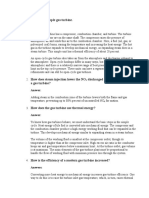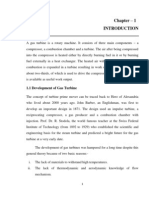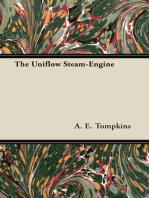Gas Turbines
Gas Turbines
Uploaded by
wayzodeneerajCopyright:
Available Formats
Gas Turbines
Gas Turbines
Uploaded by
wayzodeneerajOriginal Description:
Copyright
Available Formats
Share this document
Did you find this document useful?
Is this content inappropriate?
Copyright:
Available Formats
Gas Turbines
Gas Turbines
Uploaded by
wayzodeneerajCopyright:
Available Formats
GAS TURBINES
Unit 5
General Aspects
Probably a wind-mill was the first turbine to produce useful work,
wherein there is no precompression and no combustion. The
characteristic features of a gas turbine as we think of the name today
include a compression process and an heat addition (or combustion)
process. The gas turbine represents perhaps the most satisfactory
way of producing very large quantities of power in a self-contained
and compact unit. The gas turbine may have a future use in
conjunction with the oil engine. For smaller gas turbine units, the
inefficiencies in compression and expansion processes become
greater and to improve the thermal efficiency it is necessary to use a
heat exchanger. In order that a small gas turbine may compete for
economy with the small oil engine or petrol engine it is necessary that
a compact effective heat exchanger be used in the gas turbine cycle.
The thermal efficiency of the gas turbine alone is still quite modest 20
to 30% compared with that of a modern steam turbine plant 38 to
40%. It is possible to construct combined plants whose efficiencies
are of order of 45% or more. Higher efficiencies might be attained in
future.
Applications
The following are the major fields of application of gas
turbines :
1. Aviation
2. Power generation
3. Oil and gas industry
4. Marine propulsion.
The efficiency of a gas turbine is not the criteria for the choice
of this plant. A gas turbine is used in aviation and marine
fields because it is self-contained, light weight, not requiring
cooling water and generally fits into the overall shape of the
structure. It is selected for power generation because of its
simplicity, lack of cooling water, needs quick installation and
quick starting. It is used in oil and gas industry because of
cheaper supply of fuel and low installation cost.
Limitations
The gas turbines have the following limitations
:
(i) They are not self-starting ;
(ii) Low efficiencies at part loads ;
(iii) Non-reversibility ;
(iv) Higher rotor speeds ; and
(v) Overall efficiency of the plant is low.
Classification of Gas
Turbines
The gas turbines are mainly divided into two groups
:
1. Constant pressure combustion gas turbine :
(a) Open cycle constant pressure gas turbine
(b) Closed cycle constant pressure gas turbine.
2. Constant volume combustion gas turbine.
In almost all the fields open cycle gas turbine plants
are used. Closed cycle plants were introduced at
one stage because of their ability to burn cheap
fuel. In between their progress remained slow
because of availability of cheap oil and natural
gas. Because of rising oil prices, now again, the
attention is being paid to closed cycle plants.
A Simple Gas Turbine Plant
A gas turbine plant may be defined as one in which
the principal prime-mover is of the turbine type and the
working medium is a permanent gas.
A simple gas turbine plant consists of the following :
1. Turbine.
2. A compressor mounted on the same shaft or coupled
to the turbine.
3. The combustor.
4. Auxiliaries such as starting device, auxiliary lubrication
pump, fuel system, oil system and the duct system etc.
A modified plant may have in addition to above an intercooler, regenerator, a reheater
etc.
The working fluid is compressed in a compressor
which is generally rotary, multistage type. Heat
energy is added to the compressed fluid in the
combustion chamber. This high energy fluid, at
high temperature and pressure, then expands in
the turbine unit thereby generating power. Part of
the power generated is consumed in driving the
generating compressor and accessories and the
rest is utilised in electrical energy. The gas
turbines work on open cycle, semiclosed cycle or
closed cycle. In order to improve efficiency,
compression and expansion of working fluid is
carried out in multistages.
GAS TURBINE CYCLEBRAYTON
CYCLE
Ideal Brayton Cycle
Brayton cycle is a constant pressure cycle
for a perfect gas. It is also called J oule
cycle. The heat transfers are achieved in
reversible constant pressure heat exchangers.
An ideal gas turbine plant would perform the
processes that make up a Brayton cycle.
The various operations are as follows :
Operation 1-2. The air is compressed isentropically from the
lower pressure p1 to the upper pressure p2, the
temperature rising from T1 to T2. No heat flow occurs.
Operation 2-3. Heat flows into the system increasing the
volume from V2 to V3 and temperature from T2 to T3
whilst the pressure remains constant at p2.
Heat received = mcp (T3 T2).
Operation 3-4. The air is expanded isentropically from p2 to
p1, the temperature falling from T3 to T4. No heat flow
occurs.
Operation 4-1. Heat is rejected from the system as the
volume decreases from V4 to V1 and the temperature
from T4 to T1 whilst the pressure remains constant at p1.
Heat rejected = mcp(T4 T1).
Pressure Ratio for Maximum
Work
The pressure ratio for maximum work is a
function of the limiting temperature ratio.
Work Ratio
Work ratio is defined as the ratio of net work output
to the work done by the turbine.
Open Cycle Gas TurbineActual
Brayton Cycle
The fundamental gas turbine unit is one operating on
the open cycle in which a rotary compressor and a
turbine are mounted on a common shaft. Air is drawn
into the compressor and after compression passes to
a combustion chamber. Energy is supplied in the
combustion chamber by spraying fuel into the air
stream, and the resulting hot gases expand through
the turbine to the atmosphere. In order to achieve net
work output from the unit, the turbine must develop
more gross work output than is required to drive the
compressor and to overcome mechanical losses in
the drive. The products of combustion coming out
from the turbine are exhausted to the atmosphere as
they cannot be used any more. The working fluids
(air and fuel) must be replaced continuously as they
are exhausted into the atmosphere.
1-2 represents : irreversible adiabatic
compression.
2-3 represents : constant pressure heat
supply in the combustion chamber.
3-4 represents : irreversible adiabatic
expansion.
1-2 represents : ideal isentropic compression.
3-4 represents : ideal isentropic expansion.
Methods for Improvement of Thermal
Efficiency of Open Cycle Gas Turbine
Plant
The following methods are employed to increase
the specific output and thermal efficiency of
the plant :
1. Intercooling 2. Reheating 3. Regeneration.
From this we may conclude that when the compressor work input is reduced
then the work
ratio is increased.
You might also like
- Gas Turbine Power Plant: Fig.1-2: Components of A Basic Gas Turbine EngineDocument22 pagesGas Turbine Power Plant: Fig.1-2: Components of A Basic Gas Turbine Engineام البنين الرياني100% (2)
- Gas Turbine Power Plant PresentationDocument126 pagesGas Turbine Power Plant Presentationjehadyam100% (5)
- 06 Gas Turbine Power PlantDocument31 pages06 Gas Turbine Power PlantRishav niroula100% (1)
- Thermodynamics Lecture 6Document32 pagesThermodynamics Lecture 6MarkJude Morla100% (1)
- Thermal Power Plant: 17 Mechanical by Engr. Ans Ahmed Department of Mechanical EngineeringDocument29 pagesThermal Power Plant: 17 Mechanical by Engr. Ans Ahmed Department of Mechanical EngineeringTarvesh Kumar100% (1)
- Gas Turbine: Olar LoungeDocument34 pagesGas Turbine: Olar Loungepkdevan68100% (1)
- Gas TurbineDocument53 pagesGas Turbinedipakbag100% (1)
- Lecture 17Document27 pagesLecture 17Saleem KhanNo ratings yet
- Gas TurbineDocument25 pagesGas TurbineMohammed AlsirajNo ratings yet
- What Is An Open Cycle Gas TurbineDocument3 pagesWhat Is An Open Cycle Gas TurbineAmit B MakNo ratings yet
- Gas Turbine Power PlantDocument7 pagesGas Turbine Power PlantYuvraj GogoiNo ratings yet
- Classification of Gas Turbine Power PlantDocument7 pagesClassification of Gas Turbine Power PlantPK100% (3)
- Gas TurbinesDocument5 pagesGas Turbineswayzodeneeraj100% (1)
- Gas Turbine Cycles - LectureDocument18 pagesGas Turbine Cycles - LectureSrinu Reddy100% (2)
- 8.ME 169-Gas TurbinesDocument21 pages8.ME 169-Gas TurbinesMD MUSTAFANo ratings yet
- Chapter Five Gas Turbine Power PlantDocument23 pagesChapter Five Gas Turbine Power PlantBese Mat100% (2)
- Gas Turbine Jet PropulsionDocument34 pagesGas Turbine Jet PropulsionAányâNo ratings yet
- Plant Overview 7Document7 pagesPlant Overview 7vipulgupta2012No ratings yet
- Gasturbine 161231093609Document23 pagesGasturbine 161231093609nailanadeem221No ratings yet
- Critically Evaluate The Modifications Made To TheDocument5 pagesCritically Evaluate The Modifications Made To Theelrefaimohamed293No ratings yet
- The Brayton Cycle With RegenerationDocument14 pagesThe Brayton Cycle With RegenerationMuh Indrawan100% (1)
- Unit 3 Gas Turbines AND JET PROPULSIONDocument99 pagesUnit 3 Gas Turbines AND JET PROPULSIONSANTHOSH NAGARAJANo ratings yet
- Stirling Cycle and The Ericsson Cycle. They Differ From The Carnot Cycle in That The TwoDocument2 pagesStirling Cycle and The Ericsson Cycle. They Differ From The Carnot Cycle in That The TwoannukiitNo ratings yet
- Lec 05Document21 pagesLec 05Shamsuzzaman SharifNo ratings yet
- Per Micro ProjectDocument7 pagesPer Micro ProjectRD editar mh18No ratings yet
- Gas Turbine Working PrincipleDocument7 pagesGas Turbine Working PrincipleAhmed Mohamed SalihNo ratings yet
- Gas Turbine MaintenanceDocument146 pagesGas Turbine MaintenanceMamoun1969100% (12)
- Gas Turbine 1Document21 pagesGas Turbine 1Md. Adnan NabibNo ratings yet
- ProgressDocument29 pagesProgressVictor BettNo ratings yet
- Gas Turbine Q & ADocument39 pagesGas Turbine Q & ASaurabh Barange100% (1)
- 1-Gas Turbine DesignDocument56 pages1-Gas Turbine DesignMohammed Yusuf100% (4)
- Gas Turbine Power PlantDocument11 pagesGas Turbine Power PlantCK Godinez100% (1)
- Gas Turbine Power PlantDocument14 pagesGas Turbine Power PlantBouhadNo ratings yet
- Gas Turbine Power Plant: Rajshahi University of Engineering & TechnologyDocument23 pagesGas Turbine Power Plant: Rajshahi University of Engineering & TechnologyTahsinur RahmanNo ratings yet
- Automotive Turbocharged Gas Turbine.Document48 pagesAutomotive Turbocharged Gas Turbine.Santanu ChakrabortyNo ratings yet
- Gas Turbine F1041 & F1065Document12 pagesGas Turbine F1041 & F1065syed arimiNo ratings yet
- Brayton Cycle Reheat Regen RecollingDocument14 pagesBrayton Cycle Reheat Regen RecollingDaxit LodaliyaNo ratings yet
- University of Karbala Department of Mechanical Lecture Notes - Power Plants by Fadhel Al-MousawiDocument27 pagesUniversity of Karbala Department of Mechanical Lecture Notes - Power Plants by Fadhel Al-Mousawiحامد عبد الشهيد حميد مجيد100% (2)
- Gas Turbine DescriptionDocument8 pagesGas Turbine DescriptionSIVAPATHASEKARANNo ratings yet
- Power Point Technology AssignmentDocument5 pagesPower Point Technology AssignmentMusa Maroy StevenNo ratings yet
- Brayton CycleDocument15 pagesBrayton CycleWahyudin BetaNo ratings yet
- Pplied: ThermodynamicsDocument86 pagesPplied: ThermodynamicsAlaa Shammaa100% (1)
- 14 Gas Turbine PlantDocument4 pages14 Gas Turbine PlantAshwini SinghNo ratings yet
- Report On Gas TurbineDocument33 pagesReport On Gas TurbineKanika Kumar100% (1)
- Gas Power CycleDocument49 pagesGas Power CycleNafisa AnikaNo ratings yet
- Gas Turbine: Classification, Open and Closed Cycle, Gas Turbine FuelsDocument10 pagesGas Turbine: Classification, Open and Closed Cycle, Gas Turbine FuelsAsim TailorNo ratings yet
- Brayton Cycle: The Ideal Cycle For Gas-Turbine Engines in Relation To Power PlantsDocument15 pagesBrayton Cycle: The Ideal Cycle For Gas-Turbine Engines in Relation To Power PlantsmechturboNo ratings yet
- GPFDocument200 pagesGPFspvengiNo ratings yet
- Chapter - 04 NotesDocument11 pagesChapter - 04 Notesvkurund89No ratings yet
- Gas TurbinesDocument74 pagesGas TurbinesBhushan Patil100% (1)
- Gas-Engines and Producer-Gas Plants A Practice Treatise Setting Forth the Principles of Gas-Engines and Producer Design, the Selection and Installation of an Engine, Conditions of Perfect Operation, Producer-Gas Engines and Their Possibilities, the Care of Gas-Engines and Producer-Gas Plants, with a Chapter on Volatile Hydrocarbon and Oil EnginesFrom EverandGas-Engines and Producer-Gas Plants A Practice Treatise Setting Forth the Principles of Gas-Engines and Producer Design, the Selection and Installation of an Engine, Conditions of Perfect Operation, Producer-Gas Engines and Their Possibilities, the Care of Gas-Engines and Producer-Gas Plants, with a Chapter on Volatile Hydrocarbon and Oil EnginesNo ratings yet
- Marvel Carbureter and Heat Control: As Used on Series 691 Nash Sixes Booklet SFrom EverandMarvel Carbureter and Heat Control: As Used on Series 691 Nash Sixes Booklet SNo ratings yet
- Installation and Operation Instructions For Custom Mark III CP Series Oil Fired UnitFrom EverandInstallation and Operation Instructions For Custom Mark III CP Series Oil Fired UnitNo ratings yet
- Comparison of Diesel and Petrol EnginesFrom EverandComparison of Diesel and Petrol EnginesRating: 2.5 out of 5 stars2.5/5 (3)
- 2019 Second Year SyllabusDocument37 pages2019 Second Year SyllabuswayzodeneerajNo ratings yet
- PROJECT MGMT MTECH SyllabusDocument66 pagesPROJECT MGMT MTECH SyllabuswayzodeneerajNo ratings yet
- PresentDocument4 pagesPresentwayzodeneerajNo ratings yet
- JournalsDocument2 pagesJournalswayzodeneerajNo ratings yet
- E PDFDocument9 pagesE PDFwayzodeneerajNo ratings yet
- D PDFDocument9 pagesD PDFwayzodeneerajNo ratings yet
- C PDFDocument9 pagesC PDFwayzodeneerajNo ratings yet
- TestsDocument7 pagesTestswayzodeneerajNo ratings yet
- B PDFDocument9 pagesB PDFwayzodeneerajNo ratings yet
- WitnessDocument18 pagesWitnesswayzodeneerajNo ratings yet
- WitnessDocument27 pagesWitnesswayzodeneerajNo ratings yet
- Gas TurbinesDocument5 pagesGas Turbineswayzodeneeraj100% (1)
- Nuclear Power Plant: Unit - II Energy Conversion-IIIDocument2 pagesNuclear Power Plant: Unit - II Energy Conversion-IIIwayzodeneerajNo ratings yet







































































